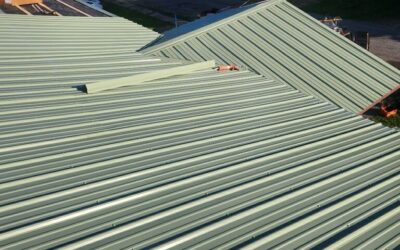Types of Roofing Underlayment: A Complete Guide with S&K Construction and Remodeling LLC
When it comes to installing or replacing a roof, the underlayment is one of the most important yet often overlooked components. It serves as a protective layer between your roof deck and shingles, providing essential waterproofing, temperature regulation, and durability. Understanding the different types of roofing underlayment is crucial to making an informed decision for your home or business.
In this comprehensive guide, we will explore the various types of roofing underlayment available, their pros and cons, and why S&K Construction and Remodeling LLC, based in Cleveland, OH, is the go-to company for roofing underlayment installation. Our team of experts will walk you through the benefits of each underlayment material and how to choose the right one for your roofing project.
What Is Roofing Underlayment?
Roofing underlayment is a material installed directly on the roof deck before the shingles or other roofing materials are applied. It serves as a secondary barrier against moisture, wind, and debris, ensuring that your home remains protected. While the primary roofing material (like shingles, tiles, or metal panels) provides the first line of defense against the elements, the underlayment acts as an extra layer of security.
Roofing underlayment is particularly important for preventing water infiltration, which can cause damage to your roof deck and the interior of your home. It also contributes to the overall insulation and energy efficiency of your building.
Why Is Roofing Underlayment Important?
Before diving into the different types of roofing underlayment, it’s important to understand why it’s a vital component of your roofing system.
1. Waterproofing Protection
One of the primary functions of roofing underlayment is to protect your roof deck from water. During heavy rain or snow, the shingles or tiles can become temporarily ineffective at keeping water out. The underlayment provides a secondary waterproof barrier that prevents water from seeping into the roof deck, which could cause significant damage over time.
2. Protection from Wind and Debris
Underlayment acts as an added layer of defense against wind-driven rain, debris, and falling objects that may impact your roof. In cases of extreme weather, such as hurricanes or tornadoes, the underlayment can help prevent water from reaching the roof deck by holding up under pressure.
3. Energy Efficiency
Roofing underlayment plays a role in improving your home’s insulation and energy efficiency. Some underlayment materials reflect heat, keeping your home cooler in the summer and warmer in the winter. This can help reduce your energy bills and enhance the overall comfort of your home.
4. Improved Durability
Underlayment adds an extra layer of protection to your roof, prolonging the life of your shingles and preventing premature wear and tear. With the right underlayment, you can reduce the frequency of repairs and replacements, ultimately saving money in the long run.
Types of Roofing Underlayment
There are several types of roofing underlayment, each with unique characteristics and benefits. The most common types are asphalt-saturated felt, synthetic underlayment, and rubberized asphalt underlayment. Let’s take a closer look at each of these materials:
1. Asphalt-Saturated Felt (Tar Paper)
Asphalt-saturated felt, commonly known as tar paper, is one of the most traditional types of roofing underlayment. It is made by saturating a fibrous base material, such as paper or fiberglass, with asphalt to make it water-resistant. Asphalt-saturated felt is still widely used in residential and commercial roofing because of its affordability and reliability.
Pros:
- Cost-Effective: Asphalt-saturated felt is one of the most affordable roofing underlayment materials, making it a popular choice for budget-conscious homeowners.
- Reliable Performance: Despite being less advanced than synthetic underlayment, asphalt-saturated felt is still effective at providing waterproofing protection and durability.
- Easy to Install: This type of underlayment is relatively easy for roofing contractors to install, and it is commonly available at most hardware and building supply stores.
Cons:
- Prone to Tears: Asphalt-saturated felt can be prone to tearing when exposed to high winds or foot traffic, which may reduce its overall effectiveness.
- Limited Durability: Asphalt-saturated felt can degrade over time due to exposure to UV rays and moisture, making it less durable than some synthetic alternatives.
- Heavy: This material is quite heavy and can be difficult to handle, which may complicate installation.
2. Synthetic Underlayment
Synthetic underlayment is a modern alternative to asphalt-saturated felt. It is typically made from polymer-based materials like polypropylene or polyester, which are woven together to create a lightweight, durable, and waterproof material. Synthetic underlayment has gained popularity in recent years due to its superior performance compared to traditional tar paper.
Pros:
- Lightweight and Easy to Handle: Synthetic underlayment is much lighter than asphalt-saturated felt, making it easier for contractors to handle and install, especially on steep or difficult-to-reach roofs.
- Superior Durability: Unlike asphalt-saturated felt, synthetic underlayment is resistant to UV rays, mold, and mildew, ensuring that it maintains its strength and functionality over time.
- Waterproof: Synthetic underlayment provides excellent waterproofing, preventing water from reaching the roof deck and reducing the risk of leaks and rot.
- Resistant to Tears and Rips: Synthetic underlayment is more resistant to tears and rips than asphalt-saturated felt, making it more durable under adverse weather conditions.
- Breathability: Some synthetic underlayment products are breathable, which allows moisture trapped in the attic to escape and reduces the risk of mold and mildew buildup.
Cons:
- Higher Cost: Synthetic underlayment is generally more expensive than asphalt-saturated felt, which may be a consideration for homeowners on a tight budget.
- Less Common: While synthetic underlayment is growing in popularity, it is not yet as widely available as asphalt-saturated felt, particularly in rural areas.
3. Rubberized Asphalt Underlayment
Rubberized asphalt underlayment is a premium option that offers exceptional waterproofing and durability. Made from asphalt combined with a layer of rubberized polymer, this underlayment is ideal for areas with extreme weather conditions, such as heavy rain or snow. It is often used for roofing projects that require extra protection, such as low-slope roofs or roofs in coastal regions.
Pros:
- Exceptional Waterproofing: Rubberized asphalt underlayment provides the highest level of waterproofing protection, making it ideal for preventing leaks and water infiltration.
- Superior Adhesion: This type of underlayment is self-adhesive, which means it bonds directly to the roof deck without the need for additional fasteners or nails. This helps create a seamless barrier that is more resistant to wind uplift.
- Durable and Long-Lasting: Rubberized asphalt is extremely durable and can withstand extreme temperatures and weather conditions. It is less likely to degrade over time compared to other materials.
- Ideal for Low-Slope Roofs: Rubberized asphalt is particularly well-suited for low-slope roofs, where water drainage can be problematic.
Cons:
- High Cost: Rubberized asphalt underlayment is one of the most expensive options on the market, which may be a consideration for homeowners with a limited budget.
- Difficult to Install: The self-adhesive nature of rubberized asphalt can make it challenging to install properly, especially in areas with extreme temperatures. It’s important to hire an experienced contractor to handle this type of underlayment.
4. Peel-and-Stick Underlayment
Peel-and-stick underlayment is a self-adhesive membrane that provides superior protection against leaks and moisture. It is similar to rubberized asphalt but is specifically designed to be easier to install. The peel-and-stick membrane can be applied directly to the roof deck, making it an excellent choice for areas prone to heavy rain or snow.
Pros:
- Waterproof Protection: Peel-and-stick underlayment offers excellent waterproofing protection, particularly in areas that are prone to leaks, such as valleys, eaves, and roof penetrations.
- Easy to Install: As a self-adhesive product, peel-and-stick underlayment is easier to install than traditional felt or synthetic underlayment, saving time during installation.
- Ideal for High-Risk Areas: Peel-and-stick underlayment is commonly used in areas where water infiltration is most likely, such as around chimneys, skylights, and vents.
Cons:
- Expensive: Like rubberized asphalt, peel-and-stick underlayment can be costly, making it less suitable for homeowners on a tight budget.
- Requires Precision: Because it’s a self-adhesive product, it requires precise installation to avoid wrinkles or air bubbles, which could compromise its effectiveness.
How to Choose the Right Underlayment for Your Roof
Choosing the right roofing underlayment depends on several factors, including the type of roof, local climate, and your budget. Here are some considerations to keep in mind when selecting underlayment for your roof:
1. Climate Considerations
If you live in an area with heavy rainfall, snow, or extreme temperatures, you may want to opt for a more durable underlayment, such as synthetic or rubberized asphalt. These materials provide superior waterproofing and performance in harsh conditions.
2. Roof Slope
For roofs with a steep slope, traditional asphalt-saturated felt or synthetic underlayment can be sufficient. However, for low-slope roofs, rubberized asphalt or peel-and-stick underlayment provides enhanced waterproofing and better protection.
3. Budget
If you’re working with a tight budget, asphalt-saturated felt can be a cost-effective solution for underlayment. However, if you’re looking for long-term durability and better performance, investing in synthetic or rubberized asphalt may be worth the extra cost.
Why Choose S&K Construction and Remodeling LLC for Your Underlayment Installation
At S&K Construction and Remodeling LLC, we are committed to providing high-quality roofing services, including expert underlayment installation. Here’s why we should be your first choice for roofing projects in Cleveland, OH:
- Experienced Roofing Professionals: Our team has extensive experience working with various types of underlayment and roofing materials. We understand the unique needs of each project and provide tailored solutions to ensure optimal performance.
- High-Quality Materials: We only use top-quality underlayment materials from trusted manufacturers to ensure the longevity and durability of your roof.
- Affordable Pricing: We offer competitive pricing on all of our roofing services, ensuring that you get excellent value for your investment.
- Customer Satisfaction: We are dedicated to exceeding our clients’ expectations with every project. From consultation to installation, we ensure that your needs are met, and your roof is secure.
Conclusion
Roofing underlayment is a critical component of your roofing system, providing essential protection against water, wind, and debris. Understanding the different types of underlayment available—such as asphalt-saturated felt, synthetic, rubberized asphalt, and peel-and-stick options—will help you make an informed decision for your home or business.
If you’re in need of roofing services in Cleveland, OH, S&K Construction and Remodeling LLC is here to help. Our team of experts will guide you through the process of selecting and installing the best underlayment for your roof. Contact us today for a consultation and let us provide you with a reliable, long-lasting roofing solution!
 (440) 307-2060
(440) 307-2060

